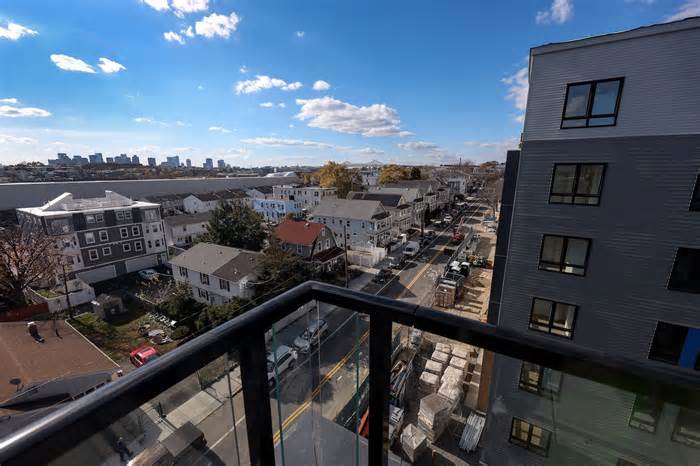
In Chelsea, a new model for public housing opens its doors
- by The Boston Globe
- Nov 08, 2024
- 0 Comments
- 0 Likes Flag 0 Of 5

The apartment complex aims to re-do public housing by mixing it with market-rate units
A view from the roofdeck of a new building in Chelsea that combines public housing for very-low-income tenants with market-rate apartments, an increasingly popular approach to redeveloping aging public housing stock in and around Boston.
Barry Chin/Globe Staff
On Central Avenue in Chelsea, thereâs a new, six-story building. It has a sprawling lobby at street level, with tile floors and new leather furniture. The apartments on the highest floors have spectacular views of Chelsea, the Tobin Bridge and the Boston skyline beyond. There is a room reserved specifically for residents to wash their dogs, and maybe soon a golf simulator.
This building, and another next to it that will be finished next year, have all the makings of every other modern luxury apartment building that many in working-class neighborhoods like Chelsea see as a marker of gentrification, displacement, and change that doesnât necessarily include them.
But these fancy buildings will actually be home to some of the cityâs poorest residents. The project, called DUO by developers Joseph J. Corcoran Company and John M. Corcoran & Company, is a new mixed-income development with 330 units, 96 of which are public housing, replacing Chelseaâs deteriorating Innes Apartments.
It took eight years of planning, permitting, and development to get to Thursdayâs ribbon-cutting on the first of the two buildings. But the $155 million project is the latest example in a promising new trend for public housing in Massachusetts: replacing the stateâs aging public housing projects with larger developments that mix public and market-rate units. The market rate units make it easier to attract private financing, while the state can pitch in funding for the public housing.
Advertisement
âWe think this is an approach that can be replicated,â JJC CEO Joseph Corcoran said on a recent tour of the project. âPublic housing, and the people that live in it, is a valuable resource for communities. This project is for the people who lived in this development and will now get to live in this new one.â
The DUO complex, on Central Avenue in Chelsea, is a newly built mixed-income apartment building that aims to combine public housing and market-rate apartments.
Barry Chin/Globe Staff
Public housing has grown increasingly difficult to redevelop over the years as state resources have dwindled and financial headwinds like land and construction costs have pushed the financing formula out of balance.
So increasingly, housing authorities have turned to mixed-income approaches to draw more private funding to help rehabilitate aging public housing stock. One huge such project broke ground last year in Charlestown, where the 1,100-unit Bunker Hill public housing project is being transformed into a 2,699-unit mixed-income development. Somervilleâs Clarendon Hill apartments are also being redeveloped using a similar model.
Advertisement
In Chelsea, along with its 96 units for very-low-income residents, DUO will include 194 market-rate units, with two bedrooms starting around $3075, and 40 âworkforce housingâ units aimed at tenants making 120 percent of the area median income or less. Rent in a one-bedroom workforce unit will run between $2,350 and $2,425. And there are no designated apartments that will always be public housing; they all come with the same finishes and amenities, and so as long as the proportion of units add up, any unit could be public housing or market rate.
âWe didnât want there to be a rich door and a poor door,â said JJC President Sean McReynolds, the project executive. âSo there will always be 96 public housing units here, but thereâs nothing saying one specific unit has to be public housing and the other has to be market rate. Theyâre all exactly the same.â
State officials are hopeful that this public-private approach can help rehabilitate their portfolio of public housing. On top of federally-funded public housing, Massachusetts is one of four states with its own portfolio of housing developments â some 43,000 units in all â and many have fallen into disrepair after decades of disinvestment.
A model apartment in Chelsea's new DUO public housing development.
Barry Chin/Globe Staff
Fixing that now, the state estimates, will cost billions, and projects like DUO may offer a sustainable path to do it. Through its Public Housing Innovations Program, the state kicked in a $30 million grant that helped developers of the Chelsea project raise most of the rest of the funding â $120 million â from traditional private financing sources. It is a delicate financing formula that the developers had to retool more than once, but it works. And now Chelsea officials have their eyes on trying to replicate it at other public housing sites in town that need repairing.
Advertisement
âWe have an obligation to find ways to redevelop these buildings for the good of our residents that live in them,â said Al Ewing, the former executive director of the Chelsea Housing Authority, who helped get the project off the ground. âThese units are a precious resource.â
Andrew Brinker can be reached at andrew.brinker@globe.com. Follow him @andrewnbrinker.
Please first to comment
Related Post
Stay Connected
Tweets by elonmuskTo get the latest tweets please make sure you are logged in on X on this browser.
Sponsored
Popular Post
Tesla: Buy This Dip, Energy Growth And Margin Recovery Are Vastly Underappreciated
28 ViewsJul 29 ,2024







 Energy
Energy

















